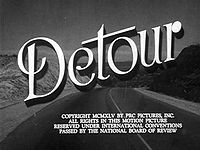
Back أفلام الطريق Arabic Road movie Catalan فیلمی ڕێگا CKB Road movie Czech Road movie Danish Roadmovie German Ŝosefilmo Esperanto Película de carretera Spanish Road movie Estonian Road movie Basque

A road movie is a film genre in which the main characters leave home on a road trip, typically altering the perspective from their everyday lives.[2] Road movies often depict travel in the hinterlands, with the films exploring the theme of alienation and examining the tensions and issues of the cultural identity of a nation or historical period; this is all often enmeshed in a mood of actual or potential menace, lawlessness, and violence,[3] a "distinctly existential air"[4] and is populated by restless, "frustrated, often desperate characters".[5] The setting includes not just the close confines of the car as it moves on highways and roads, but also booths in diners and rooms in roadside motels, all of which helps to create intimacy and tension between the characters.[6] Road movies tend to focus on the theme of masculinity (with the man often going through some type of crisis), some type of rebellion, car culture, and self-discovery.[7] The core theme of road movies is "rebellion against conservative social norms".[5]
There are two main narratives: the quest and the outlaw chase.[8] In the quest-style film, the story meanders as the characters make discoveries (e.g., Two-Lane Blacktop from 1971).[8] In outlaw road movies, in which the characters are fleeing from law enforcement, there is usually more sex and violence (e.g., Natural Born Killers from 1994).[8] Road films tend to focus more on characters' internal conflicts and transformations, based on their feelings as they experience new realities on their trip, rather than on the dramatic movement-based sequences that predominate in action films.[1] Road movies do not typically use the standard three-act structure used in mainstream films; instead, an "open-ended, rambling plot structure" is used.[5]
The road movie keeps its characters "on the move", and as such the "car, the tracking shot, [and] wide and wild open space" are important iconography elements, similar to a Western movie.[9] As well, the road movie is similar to a Western in that road films are also about a "frontiersmanship" and about the codes of discovery (often self-discovery).[9] Road movies often use the music from the car stereo, which the characters are listening to, as the soundtrack[10] and in 1960s and 1970s road movies, rock music is often used (e.g., Easy Rider from 1969 used a rock soundtrack [11] of songs from Jimi Hendrix, The Byrds and Steppenwolf).
While early road movies from the 1930s focused on couples,[6] in post-World War II films, usually the travellers are male buddies,[4] although in some cases, women are depicted on the road, either as temporary companions, or more rarely, as the protagonist couple (e.g., Thelma & Louise from 1991).[9] The genre can also be parodied, or have protagonists that depart from the typical heterosexual couple or buddy paradigm, as with The Adventures of Priscilla, Queen of the Desert (1994), which depicts a group of drag queens who tour the Australian desert.[9] Other examples of the increasing diversity of the drivers shown in 1990s and subsequent decades' road films are The Living End (1992), about two gay, HIV-positive men on a road trip; To Wong Foo, Thanks for Everything! Julie Newmar (1995), which is about drag queens, and Smoke Signals (1998), which is about two Indigenous men.[8] While rare, there are some road movies about large groups on the road (Get on the Bus from 1996) and lone drivers (Vanishing Point from 1971).
- ^ a b Salles, Walter (11 November 2007). "Notes for a Theory of the Road Movie". The New York Times. Retrieved 25 August 2018.
- ^ Danesi, Marcel (2008). Dictionary of Media and Communications. M.E. Sharpe. p. 256. ISBN 978-0-7656-8098-3.
- ^ Cohan, Steven and Hark, Ina Rae. "Introduction". The Road Movie Book. Eds. Cohan, Steven and Hark, Ina Rae. Routledge, 2002. p. 1
- ^ a b Cohan, Steven and Hark, Ina Rae. "Introduction". The Road Movie Book. Eds. Cohan, Steven and Hark, Ina Rae. Routledge, 2002. p. 1 and 6
- ^ a b c Laderman, David. Driving Visions: Exploring the Road Movie. University of Texas Press, 2010. Ch. 1
- ^ a b Cohan, Steven and Hark, Ina Rae. "Introduction". The Road Movie Book. Eds. Cohan, Steven and Hark, Ina Rae. Routledge, 2002. p. 8
- ^ Archer, Neil. THE FRENCH ROAD MOVIE: Space, Mobility, Identity. Berghahn Books. p. 2
- ^ a b c d "Road Movies". www.encyclopedia.com. Schirmer Encyclopedia of Film. Retrieved 13 September 2018.
- ^ a b c d Hayward, Susan. "Road movie" in Cinema Studies: The Key Concepts (Third Edition). Routledge, 2006. p. 335-336
- ^ Archer, Neil. THE FRENCH ROAD MOVIE: Space, Mobility, Identity. Berghahn Books. p. 20
- ^ Archer, Neil. The Road Movie: In Search of Meaning. Columbia University Press, 2016. p. 25